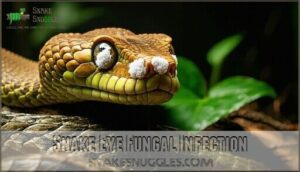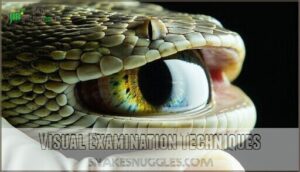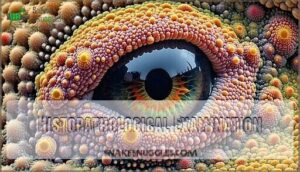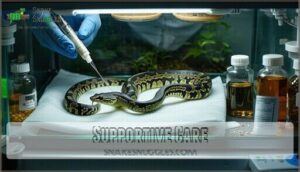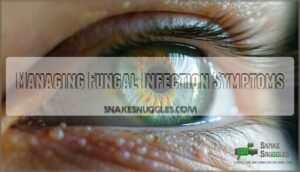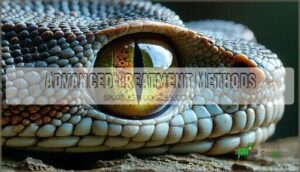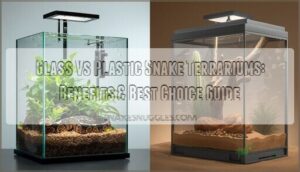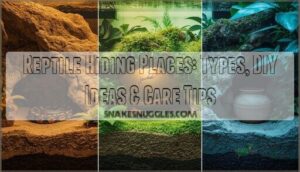This site is supported by our readers. We may earn a commission, at no cost to you, if you purchase through links.
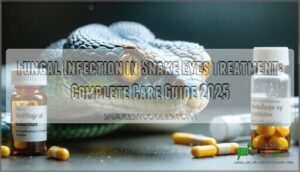
You must also adjust your snake’s environment by reducing humidity levels, improving ventilation, and replacing contaminated substrate.
Clean the enclosure thoroughly with antifungal solutions, monitor temperature gradients carefully, and isolate affected snakes to prevent spread.
Treatment typically takes several weeks with consistent medication application and environmental management, and early intervention prevents permanent vision loss, while delayed treatment can lead to systemic infection that’s much harder to resolve completely, emphasizing the importance of immediate veterinary care and proper environmental management to prevent permanent vision loss.
Table Of Contents
- Key Takeaways
- Snake Eye Fungal Infection
- Diagnosing Fungal Infections
- Treatment Options Available
- Preventing Fungal Infections
- Managing Fungal Infection Symptoms
- Advanced Treatment Methods
- Recovery and Aftercare
- Frequently Asked Questions (FAQs)
- How do you treat snake fungal infection?
- How to get rid of a fungal eye infection?
- How do you treat a snake’s eye infection?
- How do you treat a fungal infection on a snake plant?
- Are there any home remedies for snake fungal eye infections?
- Can fungal eye infections in snakes recur after treatment?
- Can fungal eye infections spread between snakes?
- How long does treatment typically take?
- Are certain snake species more susceptible?
- Can humans contract fungal infections from snakes?
- Conclusion
Key Takeaways
- You’ll need immediate veterinary care and prescription antifungal medications like itraconazole or voriconazole applied topically – don’t attempt home remedies as they can worsen the infection and cause permanent vision loss.
- You must adjust your snake’s environment immediately by reducing humidity levels, improving ventilation, replacing contaminated substrate, and thoroughly cleaning the enclosure with antifungal solutions to prevent spread.
- You should isolate affected snakes and monitor them closely during the several-week treatment process, watching for signs of recurrence, especially during shedding cycles when infections commonly return.
- You can prevent future infections through proper husbandry practices including maintaining 75-85°F temperatures, 50-60% humidity, weekly disinfection with ethanol, and providing excellent nutrition to strengthen your snake’s immune system.
Snake Eye Fungal Infection
Fungal infections affecting reptile eyes can occur when poor environmental conditions create breeding grounds for harmful organisms.
You’ll need to recognize early symptoms and understand the underlying causes to provide effective treatment for your snake’s eye health.
Causes of Fungal Infections
Your snake’s eye fungal infection typically stems from Ophidiomyces ophiodiicola, a soil-dwelling fungus that’s surprisingly tough.
This stubborn soil fungus doesn’t give up easily once it finds your snake.
Environmental exposure happens through contaminated substrate or shared hibernation sites.
Weakened immunity during brumation, poor hygiene practices, and underlying conditions create perfect conditions for snake fungal disease.
Trauma risk increases when handling infected animals or using contaminated tools between enclosures.
Antimicrobial use can disrupt normal cutaneous flora, potentially predisposing snakes to ophidiomycosis development.
Symptoms of Fungal Infections
Recognizing snake eye fungal infection early can save your pet’s vision and life. Watch for these telltale signs that something’s wrong with your snake’s delicate eye area.
Early Signs to Watch For:
- Visual Changes – You’ll notice white opaque cloudiness in the eyes, facial swelling around the spectacle, and abnormal thickening of the eye covering that blocks your snake’s normal clear vision.
- Physical Symptoms – Look for crusty scales, scabs, subcutaneous nodules, and discharge types ranging from clear to thick secretions around the affected eye area.
- Systemic Symptoms – Your snake may show anorexic behavior, abnormal basking patterns, and difficulty with normal molting processes as snake eye fungus spreads throughout their system.
Snake eye problems from snake fungal disease symptoms often start small but progress quickly. The presence of cloudy or opaque eyes is a common sign of snake fungal disease. Snake eye infection can lead to permanent vision loss if you don’t catch these snake eye fungal infection warning signs early.
Risk Factors for Fungal Infections
Several factors substantially increase your snake’s vulnerability to snake eye fungus and other fungal infections.
Compromised immunity from underlying conditions, steroid use, or antibiotic use creates perfect conditions for snake fungal disease symptoms to develop.
Environmental exposure through poor husbandry—incorrect humidity, temperature, or dirty substrates—allows snake eye infection to take hold when your pet’s defenses are weakened.
Early detection is vital, as white, opaque cloudiness can indicate a fungal eye infection.
Diagnosing Fungal Infections
Accurate diagnosis requires a systematic approach that combines visual assessment with laboratory confirmation.
Your veterinarian will examine the affected eye under magnification and collect tissue samples for microscopic analysis to identify the specific fungal species involved.
Visual Examination Techniques
When you suspect fungal infection in snake eyes, visual examination provides your first diagnostic clues.
You’ll notice swelling, cloudiness, or spectacle deformation that suggests ophthalmic mycosis.
Using slit lamp examination and direct ophthalmoscopy, you can spot subspectacular abscesses or colored exudates.
Indirect ophthalmoscopy with transillumination reveals structural changes, while dye staining helps assess surface damage in reptile eye infection cases.
Histopathological Examination
Tissue Preparation begins when you collect samples from affected snake eyes for detailed analysis.
Your veterinarian will use Staining Techniques like periodic acid-Schiff to highlight fungal structures during Microscopic Analysis.
This process reveals Cellular Changes including tissue death and inflammation, providing essential information for reptile health assessment.
Early diagnosis is vital for effective treatment, and can be found at Early diagnosis.
Proper Diagnostic Accuracy helps determine the best antifungal therapy for treating ophthalmic mycosis in your snake’s condition, which is crucial for effective treatment.
Treatment Options Available
When you discover a fungal infection in your snake’s eyes, you’ll need to act quickly to prevent permanent damage.
Time is your snake’s ally—swift action can save their sight and prevent lasting eye damage.
Treatment options range from topical antifungal medications to surgical removal of infected tissue, depending on the severity of the infection.
Antifungal Medications
You’ll need the right antifungal medications to treat your snake’s eye infection effectively.
Voriconazole works better than itraconazole, with the lowest resistance at 0.25µg/mL.
Topical antifungals treat surface lesions, while oral medications handle deeper infections.
Consider various medication options for effective treatment.
Follow dosage guidelines carefully to avoid medication side-effects and antifungal resistance in your snake eye care routine.
Surgical Intervention
When conservative antifungal treatments fail, surgical intervention becomes your snake’s lifeline.
Veterinarians perform subspectacular lavage for eye infections, create drainage ports, and remove infected tissue. In severe cases, enucleation offers complete ophidiomycosis treatment relief.
- Incision techniques – Precise cuts minimize trauma while accessing infected areas
- Post-op complications – Monitor for bleeding, swelling, or secondary infections
- Implant removal – Extract foreign materials that harbor fungal growth
- Scar revision – Address tissue damage for ideal snake eye care outcomes
Supportive Care
Beyond surgical treatment, your snake needs thorough supportive care for recovery. Thermal support through elevated temperatures optimizes immune function and enhances antifungal medication effectiveness.
Provide fluid therapy and nutritional support to combat dehydration and anorexia common with ophthalmic infections. Force-feeding may be necessary for severely ill snakes.
Maintaining proper environmental heat gradients is also vital for recovery. Environmental control, including humidity regulation and enhanced hygiene, supports wound care and stress reduction during reptile eye infections treatment, which requires careful thermal support and environmental control to ensure a successful recovery.
Preventing Fungal Infections
Prevention starts with maintaining excellent husbandry practices that eliminate the conditions fungi thrive in.
You’ll need to focus on proper environmental controls, cleanliness protocols, and nutritional support to keep your snake’s immune system strong enough to resist fungal pathogens, which is crucial for prevention.
Proper Hygiene Practices
Weekly disinfection with ethanol prevents fungal infection snakes eyes from taking hold.
You’ll need proper hand washing between handling different reptiles and jewelry cleaning of tools.
Safe products like hot soapy water work best for aftercare routine maintenance.
To guarantee a healthy habitat, consider using a reptile habitat cleaner.
Remember oral hygiene matters too – clean water prevents snake eye infection cure complications and supports reptile eye infections recovery through consistent snake fungal treatment protocols for reptile fungal infection prevention.
This approach ensures a comprehensive care plan, emphasizing the importance of healthy habitat.
Environmental Factors
Your snake’s environment can make or break their health. Temperature Control matters most—maintain 75-85°F consistently since cool conditions weaken immune systems.
Humidity Levels should stay at 50-60% for most species. Too much moisture creates perfect breeding grounds for fungal infection snakes eyes.
Enclosure Sanitation means weekly deep cleaning with ethanol-based disinfectants. Choose dry Substrate Choice materials and replace them regularly.
Good Ventilation Quality prevents stagnant air that harbors snake health issues. Regular cleaning helps in reducing fungal spore dispersal to ensure a healthy environment.
Dietary Considerations
Proper nutrition acts as your snake’s first line of defense against fungal infection snakes eyes and other snake health issues.
A balanced diet strengthens immune function, while deficiencies create vulnerabilities that opportunistic fungi exploit.
- Hydration Importance: Fresh, clean water supports natural shedding and maintains healthy skin barriers
- Vitamin Supplements: Essential nutrients boost immune response and promote faster healing from snake disease treatment
- Gut Health: Quality prey items enhance probiotic benefits and reduce pathogen introduction risks
Managing Fungal Infection Symptoms
Once you start managing symptoms of fungal infections in snake eyes, you’ll need to focus on three key areas: reducing discomfort, promoting healing, and minimizing scarring.
This stage of treatment requires careful attention to both immediate relief measures and long-term recovery strategies, which involves promoting healing.
Reducing Discomfort
When comfort becomes your priority during treatment, warm compresses work like a gentle hug for inflamed tissues.
Apply them twice daily to reduce pain and encourage drainage.
Artificial tears help combat dryness while cycloplegic drops ease muscle spasms.
| Pain Management | Application Method |
|---|---|
| Warm compress | 10-15 minutes, twice daily |
| Artificial tears | 2-3 drops every 4 hours |
| Cycloplegic drops | As prescribed by veterinarian |
These comfort measures target swelling control and itch relief without compromising antifungal therapy.
Environmental humidity control also soothes irritation naturally.
Promoting Healing
Recovery begins with targeted antifungal medications that attack fungal infection in snakes‘ eyes directly.
You’ll need consistent wound care and veterinary medicine expertise to support tissue regeneration effectively.
- Apply topical antifungals – Natamycin and voriconazole penetrate infected tissues for treating snake fungus.
- Maintain ideal environment – Proper humidity and temperature boost immune response naturally.
- Provide nutritional support – Enhanced diet accelerates healing in fungal infection in reptiles.
- Monitor progress closely – Regular veterinary checkups guarantee pain management and recovery success.
Minimizing Scarring
Prompt antifungal treatment prevents extensive tissue damage that leads to permanent scarring in snake eyes.
You’ll want to start therapy immediately when you notice infection signs.
Mesenchymal stem cell therapy shows promise for scar reduction by reducing inflammation and promoting healthy collagen production.
Combining subconjunctival fluconazole with topical treatments shortens healing time and minimizes keloid prevention needs in reptiles.
Advanced Treatment Methods
When traditional treatments don’t provide complete healing, you’ll need to ponder advanced therapeutic approaches that target fungal infections more aggressively.
These cutting-edge methods offer hope for severe or treatment-resistant cases that haven’t responded to standard antifungal medications.
Laser Therapy
Laser therapy increasingly shows promise for refractory snake eye fungal infections.
Argon laser phototherapy enhances healing by improving circulation and reducing inflammation, with documented cases showing corneal infiltrate resolution within one week.
Treatment duration varies based on infection severity and fungal species response.
The laser’s effectiveness stems from disrupting fungal biofilms while promoting tissue repair.
A key preventative measure involves proper habitat hygiene to minimize fungal exposure.
Pain management during therapeutic interventions remains minimal, as reptile fungal disease responds well to this ophthalmic care approach with excellent laser safety profiles.
Photodynamic Therapy
Photodynamic therapy (PDT) uses photosensitizers like Rose Bengal with light activation to target fungal infections in snake eyes.
This therapeutic intervention generates reactive oxygen species that destroy fungal DNA and disrupt biofilms.
Treatment efficacy varies by species – Fusarium responds better than Aspergillus, and PDT shows promise for drug-resistant cases, with future applications expanding through enhanced protocols and combination approaches for reptile fungal disease management.
Emerging Treatments
Scientists are exploring Novel Antifungals, Gene Therapy, and Immunotherapy for fungal infection snakes.
These treatments target genetic pathways and immune responses.
Microbiome Modulation helps restore healthy bacteria balance while Stem Cell Therapy regenerates damaged eye tissue.
Veterinary ophthalmology advances offer hope for antifungal for snakes resistant to traditional medications, revolutionizing reptile diseases treatment.
Recovery and Aftercare
After successful treatment, you’ll need to follow specific care steps to guarantee complete healing and prevent future infections.
Proper aftercare and regular monitoring are essential for your snake’s long-term eye health and overall recovery.
Post-Treatment Care
After successful fungal infection treatment, your snake needs careful wound care and infection prevention.
Keep the affected eye area clean with gentle antiseptic solutions. Provide proper humidity levels and maintain sterile enclosure conditions.
Support healing with vitamin supplements, especially B complex and vitamin A. Schedule regular follow-up visits with your reptile veterinarian for pain management and scar reduction monitoring.
Monitoring for Recurrence
Why does recurrence happen even after your snake seems completely healed?
Fungal infection in snakes‘ eyes can return if microscopic spores remain hidden in tissue layers.
Watch for new lesions during regular checkups, especially after shedding cycles, as early detection through symptom awareness prevents major setbacks.
Monitor your pet closely for six months post-treatment, as ophthalmic treatment success requires ongoing vigilance and preventative measures.
Long-Term Prognosis
Your snake’s recovery outlook depends heavily on infection severity and treatment timing.
Mild superficial infections typically heal completely with proper veterinary treatments, while deep infections affecting vision may cause permanent Vision Impairment.
Long-Term Medication and Lifestyle Adjustments help minimize Recurrence Risks.
Reptile veterinary care and ongoing fungal disease management support better outcomes for ophthalmic treatment success.
Frequently Asked Questions (FAQs)
How do you treat snake fungal infection?
Unfortunately, there’s no cure for snake fungal disease, but you’ll need to isolate affected reptiles immediately.
Consult an exotic veterinarian for antifungal treatments like itraconazole or voriconazole to manage symptoms.
How to get rid of a fungal eye infection?
See your doctor immediately for proper diagnosis and prescription antifungal medication.
Don’t try home remedies – eye infections can cause serious damage if untreated, and you’ll need professional care to identify the specific fungus type, which requires proper care.
How do you treat a snake’s eye infection?
Like a careful guardian watching over a slumbering serpent, you’ll need to act swiftly when spotting eye trouble.
Clean the infected eye gently with saline solution, apply prescribed antifungal drops.
And consult an exotic veterinarian immediately for proper diagnosis and treatment.
How do you treat a fungal infection on a snake plant?
Remove infected leaves immediately and improve air circulation around your plant.
Apply a fungicide specifically designed for houseplants, following label directions carefully.
Reduce watering frequency and make certain proper drainage to prevent future fungal growth.
Are there any home remedies for snake fungal eye infections?
Looking through a snake’s cloudy eyes is like peering through frosted glass – you can’t see the problem clearly.
Don’t try home remedies for fungal eye infections in reptiles.
You’ll need prescription antifungal medications from an exotic veterinarian immediately.
Can fungal eye infections in snakes recur after treatment?
Yes, fungal eye infections in snakes can definitely recur after treatment.
You’ll need to monitor your snake closely for symptoms like cloudiness or discharge.
Incomplete treatment, poor husbandry conditions, or weakened immunity often trigger relapses, requiring prompt veterinary attention.
Can fungal eye infections spread between snakes?
Fungal infections between snakes spread through shared environments, contaminated equipment, and direct contact.
You’ll want to quarantine infected snakes immediately and disinfect all surfaces, water bowls, and handling tools to prevent transmission to healthy snakes, which is a crucial step in preventing the spread of infections.
How long does treatment typically take?
Treatment duration varies from weeks to several months, depending on severity and your snake’s response.
You’ll need consistent antifungal medications, proper humidity control, and regular vet checkups to monitor progress effectively.
Are certain snake species more susceptible?
Like some breeds of dogs face more health challenges, certain snake species do have higher susceptibility to eye infections.
Ball pythons, boas, and other thick-bodied species you’ll find are more prone to fungal eye issues due to higher humidity requirements and shedding complications.
Can humans contract fungal infections from snakes?
Zoonotic transmission from snakes to humans is extremely rare, but you shouldn’t completely dismiss the possibility.
Most snake fungal infections won’t jump to people, yet immunocompromised individuals face higher risks when handling infected reptiles, especially those with fungal infections.
Conclusion
Successfully treating fungal infection in snake eyes treatment requires unwavering dedication that can literally save your reptile’s sight forever.
You’ll achieve the best outcomes by combining immediate veterinary intervention with consistent antifungal medications like itraconazole or voriconazole.
Don’t forget to maintain proper environmental conditions, including reduced humidity and improved ventilation.
Monitor your snake closely during recovery, watch for any signs of recurrence, and follow your veterinarian’s complete treatment protocol to guarantee lasting eye health and ensure the treatment is successful with consistent antifungal medications.
- https://www.gardenwildlifehealth.org/wp-content/uploads/sites/12/2018/02/Reptile-SFD.pdf
- https://cwhl.vet.cornell.edu/disease/snake-fungal-disease
- https://parcplace.org/wp-content/uploads/2022/06/WFP-Fact-Sheet%E2%80%93Ophidiomycosis_3.pdf
- https://www.merckvetmanual.com/multimedia/table/antimicrobial-drugs-used-in-reptiles
- https://www.petmd.com/reptile/conditions/parasitic/c_rp_fungal_disease

